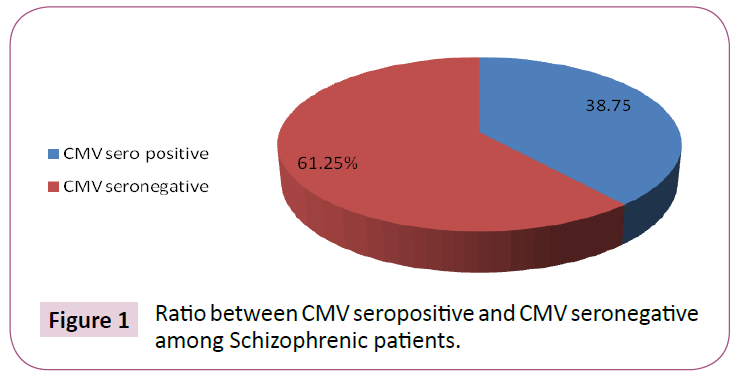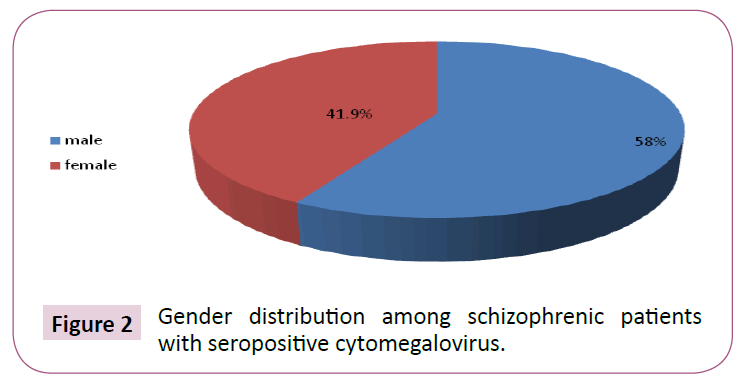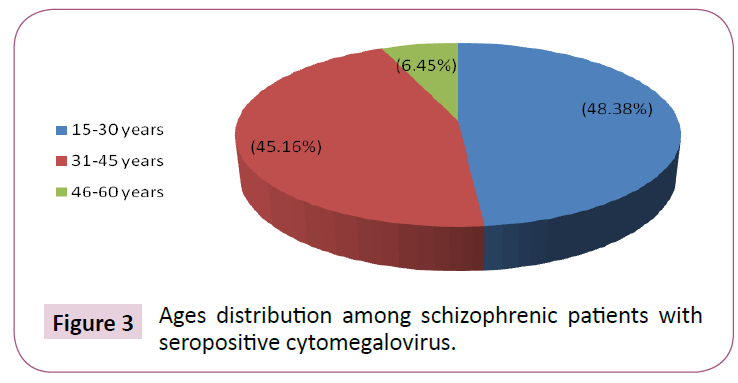Keywords
Seroprevalence; Cytomegalovirus; Schizophrenia; Khartoum; Sudan
Introduction
HCMV is a pathogen Beta-herpes virus able to establish lifelong persistent infections, which normally remain asymptomatic. However, severe diseases may develop resulting in a wide spectrum of clinical manifestations, especially in immunologically impaired individuals (e.g. AIDS patients and transplant recipients) or in congenitally-infected newborns [1].
Schizophrenia is a mental disorder characterized by abnormal social behavior and failure to understand what is real [2]. Common symptoms include false beliefs, unclear or confused thinking, hearing voices that others do not hear, reduced social engagement and emotional expression, and a lack of motivation [2,3].People with schizophrenia often have additional mental health problems such as anxiety, depressive, or substance-use disorders[4]. Symptoms typically come on gradually, begin in young adulthood, and last a long time [3,4].
Exposure to human herpes viruses is a possible biological risk factor for schizophrenia. Human herpes viruses include herpes simplex virus 1 (HSV-1), herpes simplex virus 2 (HSV-2), Cytomegalovirus (CMV), Epstein-Barr Virus (EBV), human herpes virus 6 (HHV-6), and varicella-zoster virus (VZV). All of these viruses are capable of infecting the central nervous system and establishing latent infection. Exposure to CMV has been associated with recent onset schizophrenia and maternal antibodies to HSV-2 are associated with an increased risk of schizophrenia in the offspring [5].
Studies have reported that some patients experiencing initial episodes of schizophrenia have increased levels of IgG antibodies against CMV in their sera and CSF. Treatment with antipsychotic medications may result in a decrease in CMV antibodies, while treatment with anti-herpes or anti-inflammatory drugs may reduce symptoms in some patients with schizophrenia. The strongest argument against the role of CMV in schizophrenia is the absence of traditional neuropathological changes in brains of individuals with schizophrenia [6].
Congenital CMV infection occurs in approximately 0.2%-2.5% of all live births; infection is more prevalent in underdeveloped countries and among lower socioeconomic groups in developed countries, where crowding is more common [7-12]. Both primary and recurrent infections in the mother during pregnancy may result in congenital CMV infection. On average, 1-4% of susceptible women acquire primary CMV infection during their pregnancy [10,11]. Approximately 10% of sero-positive pregnant women have reactivation of CMV infection during their pregnancy [11]. The transmission rate after primary infection is about 40%, whereas the transmission rate after recurrent infection is about 1-3% [13,14].
Rationale
Schizophrenia (SCZ) is a serious debilitating chronic brain disorder characterized by psychosis, disorganized thinking and behavior, and “negative” symptoms. It affects approximately 1% of the population worldwide and is one of the leading causes of years lost due to disability according to the WHO: The global burden of disease. Pharmacological treatments do exist but their efficacy is poor and they come with many adverse side effects.
There's an old statement hypothesize "cytomegalovirus as a possible etiological agent in schizophrenia". Laboratory work on this hypothesis was carried out and the results reported finding viral particles in the cerebrospinal fluid of the schizophrenic patients. Techniques for identification and isolation at that time were poorly developed, but improved markedly in more recent years.
Since the infection of CMV is widely spread in Sudan and well known to cause illness in human because the virus set latency and reactivation in the CNS, in this study we aim to know the relationship between this virus and developing Schizophrenia, though control and reduce the chance of developing it by giving antiviral agents if possible.
Objectives
General objectives
To know the seroprevalence of cytomegalovirus among schizophrenic patients.
Specific objectives
• To detect immunoglobulin type (IgM) specific to CMV in schizophrenic patients.
• To detect prevalence of CMV among schizophrenic patients and correlation between CMV and schizophrenia.
• To determine the association between CMV and age and sex.
Materials and Methods
Study design
A hospital based prospective cross-sectional study.
Study area
This study carried out in Eltigani Elmahy and Abdelaal Eledrisi psychiatric hospitals in Khartoum State.
Study period
All Schizophrenic patients were included.
Inclusion criteria
Patients diagnosed with schizophrenia.
Exclusion criteria
Patients with history of head trauma and other neurological disorder.
Sample size
Eighty known schizophrenic patients involved in the study.
Sampling technique
Convenient non probability sample will be chose to meet the objectives.
Data analysis
Collected data analyzed by a computer system using statistical package for social science (SPSS) program using the Chi square test and cross-tabulation. Statistical significant set at p-values<0.05.
Ethical Consideration
Permission from parents taken and them aware with the study and the results obtained. The study protocol reviewed and passed by the Ethical and Scientific Committees of UST.
Specimens’ collection
By using sterile syringe (5ml) under aseptic condition, 5ml venous blood sample collected from the patient in the sterile plane container and allow to clotting at room temperature and then centrifuge at 12000 rpm for 5 minutes to obtain the serum. Then the serum sample will separate in other sterile container and store at -20°C.
Specimens’ storage and precautions
Sample stored at -20â?? for long time and 4-8â?? for up to 5 days, avoided hemolysis, lipaemic, or bacterial contamination of sera.
ELISA procedure
An Enzyme Immunoassay (EIA) for qualitative detection of the total antibodies (IgM) to CMV in the human serum or plasma.
Principle of test
The CMV antibody EIA test kit is a solid phase qualitative enzyme immunoassay based on a sandwich principle for the detection of total antibodies (IgM) to CMV in human serum or plasma. The micro well plate will coat with CMV recombinant antigens. During testing, the specimens will add to the antigen coated micro well plate and then incubate. If the specimens contain antibodies to CMV it will bind to the antigens coated on the micro well plate to form immobilized antigen-CMV antibody complexes. If the specimens do not contain antibodies to CMV the complexes will not be formed. After initial incubation, the micro well plate should washed to remove unbound materials. The enzyme conjugated recombinant CMV antigen will add to the micro well plate and then incubate. The enzyme –conjugated CMV antigens will bind to the immobilized antigen-CMV antibody complexes present. After the second incubation the micro well plates washed to remove unbound materials substrate A and substrate B will add and then incubate to produce blue color indication the amount of CMV antibodies present in the specimens. Sulfuric acid solution will add to the micro well plates to stop the reaction producing a color change from blue to yellow. The color intensity, which corresponds to the amount of CMV antibodies present in the specimens, will measure with a micro plate reader.
Assay procedure
All reagents and specimens to room temperature (18-20â??) prior to testing and procedure must be strictly followed.
Steps
Working wash buffer will prepare by diluting the concentrate wash buffer 1:25.
Add each 100ql of ready to use controls into the appropriate wells of micro well plate.as:
Leave well A1 as blank well.
Well B1 and C1 for negative control.
Well D1and E1 for CMV positive control.
Starting from well H1 for specimen 1.
1. Mix gently and cover the micro well plate with the plate sealer and incubate at 37â?? for 30 min.
2. Remove the plate sealer and wash each well 5 time with the working wash buffer [by automated washer] and turn the micro well plate upside down on absorbance tissue.
3. Add 100ql of conjugate to each well except for the blank well.
4. Cover the micro well plate with the plate sealer and incubate at 37â?? for 20 min.
5. After incubation wash all well with working buffer (repeat step 4).
6. Add 50ql of substrate A and B to each well. Mix then cover micro well plate with plate sealer and incubate at 37â?? for 10 min.
Remove the plate sealer and add 50ql of stop solution to each well.
7. Read absorbance [optical density] by micro well reader of each well at 450 nm within 30 min.
Results
This study carried out in Eltigani Elmahy and Abdelaal Eledrisi psychiatric hospitals in Khartoum state during the period from December 2017 to March 2018. Eighty diagnosed schizophrenic patients are eligible for inclusion in this study. Frequency of CMV seropositive in all the 80 patients diagnosed with schizophrenia, the CMV seropositive detected in 31 patients with the percentage 38.75% (Figure 1). 18 of seropositive patients were males with the percentage 58.06%, while 13 of them were female with the percentage 41.9% (Figure 2). The age groups ranging between 15 to 60 years old, 15 of them were in the range of 15-60 years with a percentage of 48.38%, 14 were in the range of 31-45 years with a percentage of 45.16%, and 2 of them were in the range of 46-60 years with a percentage of 6.45% (Figure 3).

Figure 1:Ratio between CMV seropositive and CMV seronegative among Schizophrenic patients..

Figure 2:Gender distribution among schizophrenic patients with seropositive cytomegalovirus.

Figure 3:Ages distribution among schizophrenic patients with seropositive cytomegalovirus.
Discussion
Cytomegalovirus is a member of the human herpes virus family. It's large, linear, double-stranded DNA. It measure about 235kb in size. CMV is one of the most successful human pathogens, it can be transmitted vertically or horizontally usually with little effect on the host, in developed countries i.e-a high standard of hygiene, 40% of adolescents are infected and ultimately 70% of the population is infected. In developing countries, over 90% of people are ultimately infected.
According to our study, in which showed the prevalence of CMV virus in schizophrenic patients, in a period from December 2017 to January 2018 in Khartoum state hospital with the following finding Total of 80 schizophrenic patient were tested for CMV virus 31were seropositive to CMV virus by percentage of 38.75%. Our results agree with finding of Faith Dickerson reported sample of 323 individuals with schizophrenia comprised 193 men and 130 women with a mean age of 42.0 years. A total of 216 individuals in the sample (73.2%) were positive. E. Fuller Torrey suggest that CMV may play an etiological role in schizophrenia. Epidemiologically, both have a worldwide distribution and an increased prevalence in lower socioeconomic groups. Studies have reported that some patients experiencing initial episodes of schizophrenia have increased levels of IgG antibodies against CMV.
In current study, the CMV was found to be increased in males more than females and especially increased in the age ranging between 15to45 years with a percentage of 93.55%, while the percentage of patients ranging between 46to60 was found to be 6.45%.
Picchioni MM, Murray RM study the relation between Schizophrenia and CMV and found that 1.4 times more frequently in males than females, and typically appears earlier in men the peak ages of onset are 20–28 years for males and 26–32 years for females.
Conclusion
The CMV was establish to be increased in men more than women and particularly augmented in the age ranging between 15 to 45 years with a percentage of 93.55%, while the percentage of patients ranging between 46 to 60years was 6.45%.
Recommendations
Further studies with large sample size and advanced molecular techniques recommended. Furthermore we recommend to use Cytomegalovirus screening tests as routine investigation in psychiatric clinics , also antiviral agent influence must be consider in the subsequent studies.
36599
References
- Kenneson A, Cannon MJ, (2007) Review and meta-analysis of the epidemiology of congenital cytomegalovirus (CMV) infection. Rev Med Virol. 17: 253–276.
- Lavretsky H (2008) History of Schizophrenia as a psychiatric disorder. In: Mueser KT, Jeste DV, editors. Clinical Handbook of Schizophrenia. New York, New York: Guilford Press. 3–12.
- Crismon L, Argo TR, Buckley PF (2014) Schizophrenia. In: DiPiro JT, Talbert RL, Yee GC, et al. editors. Pharmacotherapy: A Pathophysiologic Approach. 9th ed. New York, New York: McGraw-Hill. 1019–1046.
- Beck AT, Rector NA, Stolar N, Grant P (2009) Schizophrenia: Cognitive Theory, Research, and Therapy. New York, New York: Guilford Press; 2009. Biological Contributions. 30–61.
- Leweke FM, Gerth CW, Koethe D, et al. (2004) Antibodies to infectious agents in individuals with recent onset schizophrenia. Eur Arch Psy Clin N. 254: 4–8.
- Shrikhande S, SR Hirsch, JC Coleman, MA Reveley, R Dayton, et al. (1985) cytomegalovirus and schizophrenia. a test of a viral hypothesis. Br J Psychiatry. 146: 503-506.
- Nelson CT, Demmler GJ (1997) Cytomegalovirus infection in the pregnant mother, fetus, and newborn infant. Clin Perinatol. 24: 151-160.
- Stagno S (1999) Cytomegalovirus. In: Behrman RE, Kliegman RM, Jenson HB, eds. Nelson textbook of pediatrics. Philadelphia, W.B. Saunders Co. 981-983.
- Hicks T, Fowler K, Richardson M, Dahle A, Adams L, et al. (1993) Congenital cytomegalovirus infection and neonatal auditory screening. J Pediatr: 123: 779-782.
- Lagasse N, Dhooge I, Govaert P (2000) Congenital CMV-infection and hearing loss. Acta Otorhinolaryngol Belg. 54: 431-436.
- Brown HL, Abernathy MP (1998) Cytomegalovirus infection. Semin Perinatol. 22: 260-266.
- Adler SP (1999) Acquired cytomegaloviral infection. In: McMillan JA, DeAngelis CD, Feigin RD, et al. eds. Oski's pediatrics: principles and practice. Philadelphia: Lippincott Williams & Wilkins. 1131-1134.
- Peckham C, Tookey P, Logan S, Giaquinto C (2001) Screening options for prevention of congenital cytomegalovirus infection. J Med Screen. 8: 119-124.









